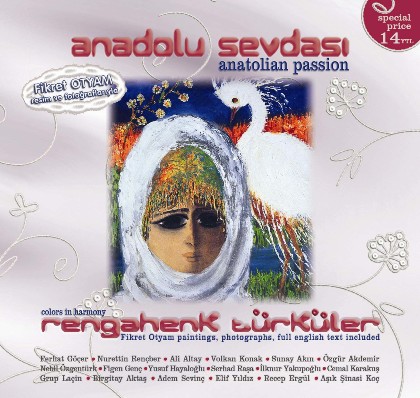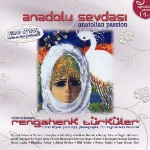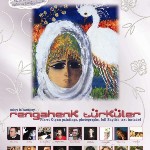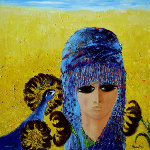
Songs
- artist:Various Turkish Folk Songs Artists
- featured artist:Various Turkish Folk Songs Artists
- release year:2007
- style(s):Folk, Turkish
- country:Türkiye
- formats:CD (Compact Disc), MC (Music Cassette)
- record posted by:Artvizyon Music&Film
- label:Artvizyon Music&Film
- publisher:Artvizyon Music&Film
- buy this record
COLORS IN HARMONY (RENGAHENK TURKULER )
ANATOLIAN PASSION (WITH FIKRET OTYAM PHOTOGRAPHS AND PAINTINGS) CD BOOK
Artvizyon, like before, is making another contribution to the Turkish Folk Music. Similar to the first Rengahenk CD-album that was enriched with Nuri Iyem paintings, this time it is Fikret Otyam who is in the spotlight. What can be said? Mr. Otyam wrote a commentary on the third volume of my “Folk Songs with Stories”.
“…I have been compiling since 1957. I have been asking about and investigating the folk song stories. I said “oh” for years, I wished someone did this job in a scientific matter. I wished the originals and stories of those lovely folk songs didn’t get lost and were written as notes in the correct form. When the wishes come true, one feels the joy of life. My wish must have come true, because one person came up. That person is Yasar Ozurkut.”
This approach of Otyam has been my biggest reward. I was honored. Doing my best, I put many years of effort to make the folk songs everlasting. However, my work is nothing compared to his. The reason is that Fikret Otyam has a different impression on everyone. Some remember him for his amazing interviews at the Cumhuriyet newspaper, some for his books, some for the documentary photographs he took and some for his grasping paintings. Most people do not know about his efforts for the folk songs and folk singers. However, he is the one who helped Mahzuni to accomplish. He made efforts for Feyzullah Cinar, Sabahat Akkiraz and many more performers. And one of his biggest sorrows is that the compiling work he did for TRT in 1970s at Southeast and East Anatolia became a big secret. He submitted to TRT the tapes of folk music he compiled and recorded after days of extensive work, but he never heard about them again. That must be the reason why he submitted the compilation work he has done since 1957 to Mannheim Alevi Cultural Center in Germany. In this way, he avoided his efforts to get lost.
In short, Artvizyon, killing many birds with one stone, is presenting the journalist, writer, photographer, artist, Fikret Otyam to the readers-listeners, accompanying the folk songs he loved and worked on and also his paintings. Folk music is garnished with the paintings that came out of the brush of a real public artist. Live long Fikret Otyam, Thank you Artvizyon.
It was July 1953. He got on a truck in Sirkeci with his camera on his shoulder and arrived in Bilecik after a rough journey leaving behind Aksaray, Adana and Antep. He stopped at the edge of Firat river. He got on a slovenly raft, travelled to the other side of Birecik’s coast..then Urfa, Diyarbakir, Mardin. He recorded human scenes both in his heart and camera. And he fell in love with both people and land of that region…With people who suffered for years…and with its land that stayed infertile for a lifetime…
Yes, his name was Fikret Otyam..Almost half a century ago, he passed on the voice of low hearted and shouldered Anatolian people to us, to everyone but mostly to Ankara…Sometimes this voice was heard. Mostly it remained low…
Anatolia..Far, quiet and lonely Anatolia..Many years ago…One man lived on the immense roads of Anatolia. He opened a window to the Anatolia from the west. A camera in his hand, Anatolia love in his heart, he told about tired, poor and helpless Anatolian people one by one…Brother of the people of the east, their loud voice that reached Ankara, Fikret Otyam.
According to Fikret Otyam, there were two things that made us human; loyalty and love, add peace to these two and then the world becomes livable…
He transferred the human love he has within to canvas first creating tens of paintings, and then to the objective-glass. And he took thousands of human scenes from Anatolia…His pen was loaded with loyalty and love for years, for pages..Fikret Otyam was one of those who had the newspaper reader have a taste of interviewing and the articles full of sorrow and joy that talked about mostly the color and identity of the Anatolian people and sometimes the cunning of the countryman…
Today if GAP is spoken as Turkey’s pride, there is Otyam’s signature beneath it. And also if today it is said “we need education! We need jobs, food!”, you should know Fikret Otyam voiced it first in 1950s and 60s…Thus, didn’t Otyam become a true friend of the Anatolian people by sometimes yelling “oh father” on the mine fields among those who didn’t own land in a matter of life and death? Anatolian man never left him alone as expected! Eventually a huge life came into presence which never turned his back to people and wrapped his dagger wounds with them. A huge life that made loyalty and love his companions…Hey! A huge plane-tree, Brother Fikret…
He ascends the uphill road of Babiali with the stories in the diaries he kept when he was an apprentice at his father’s pharmacy…And one day he reads one of his stories to a friend at Yorgo’s pub…He doesn’t stop reading although he thinks the man with a filthy coat sitting at the next table is a cop..
A man is sitting…his collar is up, a man with green eyes..I am scared; cops are following us then…We were always scared of cops..My story was published, I read it to my friend. Before that, the man was listening to us. When I read the story, he turned to us: “Hey you ! why don’t you write as you tell him” he said to me. I turned to see who he was; Sait Faik…We became close friends till he died..Whether it was his will or showing me the way, I always tried to write as I told…
A Sip of Humanity – From Fikret Otyam Documentary
An Anatolian Lantern: Fikret Otyam
Those that live their life as a novel
These marks in every square of their life
One day he will offer you as a gift
The master’s journey that started on December 19, 1926
Flows from the desert of Aksaray
To the depth of Anatolian reality
Those who first saw the torch in his hand
Ibrahim Calli and Bedri Rahmi Eyuboglu
All the colors that exist, all the photographs to be taken
Reaching to the eternity of the magic of all words
Turning his pen into a sword
To let him run to Anatolia’s smell of soil
Would they have given him this light?
Thus if we look at the fountain of his life from here
We can realize the love of being an Anatolian saint..
Writing the opposite of what those said “Write journalist, write”
Awakening those who said “Talk master talk”
Mother Hatca’s rugs that he engraved to his heart
Adding sorbet on the cold yogurt drink he drank
Greeting Memo brother in the field and being greeted back
Sorrow was sleepless when he didn’t write
His dagger at the songs of morning roosters
He wouldn’t stay alone, becoming the knight of the dark streets
Roaring of Dadaloglu
At the rearing of Koroglu’s white horse
The sweater of Pir Sultan Abdal
And the soul of Emre Taptik are entrusted to his safekeeping...
Yet those rejecting the safekeeping today
It is meaningful to tell them and have them listen to Fikret Otyam folk songs
Yet to those that are violating the map of humanity
Yelling out for an Anatolian lantern is a resistance of strength
Yet those who don’t care about the homes that are destroyed in Iraq
But his light of courage is on over the curse of the dark century
Think about the forts of poverty in the mid 1900s
Continuously knocking them down and transforming them to folk songs
Turning his dirges into the smell of Anatolian bread
Choosing to be the person who gives without any bargain
Giving love to the children of folk songs
Receiving many awards at the same time
Did not accept the nation artist award in 1998
What is it that you suffer?
What is it that you expect?
Today using the concept of being an artist irresponsibly
Your children that do not respect the history you are against
And at the same time you are a real history lover
Darkness is dripping from the chest of Anatolia that you call my blind love
I know you will say our brightness
Will revitalize them, they will be cheered up too and learn even though late
Even though late they will realize love, giving unconditionally
You say stars never end in Anatolia
You embroided thousands of papers even while saying “Go to
Your real love hey saints”, on fake wood
You hit on real but real nails
Your light on the faces that bathed in the house of folk songs
In the bazaar of folk songs you have children on fire like Nesimi Cimen
In the house of folk songs you have fire of love like Muhlis Akarsu
You are the plectrum of saz in the flags of folk songs like Hasret Gultekin
Fortunately you gave birth to the history with your childhood
Fortunately you weaved history in Harran meadow
Fortunately you drank the water of Munzur with the antelopes
Now during the veteran symphony at the bottom of Toros
We salute you!
We applause you!
My master, crying out the history of sorrow
Live long, speak long
Keep on telling us about Orhan Kemal
Keep on telling us about Yasar Kemal
Let’s erase that darkness off your bright notebook
Let’s paint those lines in your face
Let the hair in your beard be our freedom
The folk songs on fire in your heart are our love
Go on scattering the dust of my coyness
We kiss the hands of your folk songs
Why don’t we catch fire with Father Fikret’s life note?...
We cannot explain the phenomenon that we confront by the evolution of music alone.Today music has become totally a part of the entertainment sector. It is produced and forgotten as a temporary consumption object. However, music is neither a temporary consumption object nor an entertainment production alone. It is an artistic creation of human emotions where every life situation is expressed. There is a need for music not only to have fun but also to feel sorrow. As in other types of art, music provides both the communication and training of feelings. Folk tunes which are as old as the history of the humanity are an explicit confirmation.
As a broader statement, folk songs can be comprehended as an archival memory of the nations they belong to. In addition to their written and tangible remainings that are the main carriers of the cultural history, folk tunes continue their existence from ear to ear and display a mutuality and similarity based on the past of the societies, shortly the ideals of humanity. Besides, this similarity is not limited only by the neighboring societies. This affinity, occasionally uniformity, in the tunes brings out the question of how this mutuality came into presence between geographies far apart. The similarity of human nature reveals the single answer.
The ideal and culture of humanity to form takes a period of hundreds of generations. The word repertoire that is transferred from generation to generation needs to be seen as the mutual heritage of all humanity rather than belonging to one nation. Folk tunes with their plain aspects in terms of the musical and word structure, are suggesting people tolerance, friendship and love and pointing out to the ability of living together. In the world we live where we are surrounded with negativity, it can sometimes be a dream even to hope there is a way out. However, history shows us that hostility and grudge could only exist through a few generations. In this regard, folk songs are the products which keep this hope alive and ferment and accumulate the ideals of the humanity.
It is observed in our country that a systematic and intensive compilation of the folk tunes was barely attempted in 1930s. It is said that today those that are recorded and approved by TRT are between six and seven thousand at the most. On the other hand, art music pieces reach twenty thousand. The reason is that the history of the written music goes back 150 years and the composers of the art music pieces are known whereas folk songs have an anonymous character. For this reason, compiling and archiving the folk songs become more important. This artwork is willing to provide a modest contribution accomodating 18 soloists who like to sing folk songs whether it is their job or not and also many folk songs that are compiled from different regions
The esteemed artist, Fikret Otyam, enriching this album of the *Rengahenk Folk Songs series with his paintings and photographs, is providing indisputable contributions to our cultural world with the folk songs he compiled and also his photographer, artist and journalist identity. Seeing Fikret Otyam in *Rengahenk Folk Songs, who contributed to albums of many folk poets by design, photographs, paintings and folk songs, is one of the factors that enrich this project and also it is a way of showing respect for his valuable work. Moreover, when the visual material is glanced, it will be recognized that he added a living dimension to the folk songs. Undoubtedly, the main contribution to this project is provided by first the producer’s and then other musicians’ sacrificing efforts, who are involved in this project with their vocals and instruments. Without this unconditional love for music, this international quality artwork that is introduced with self-confidence to all folk song lovers, native or foreign, would not be actualized.
Rengahenk Folk Songs(*) continue!
(*)Colors in harmony
TRACK LIST AND PERFORMERS
1.Yarim Yarim-Ferhat Gocer
2.Ay karanlik Gece Vurdular Beni-Nurettin Rencber
3.Ince Memet-Ali Altay
4.Aynalar - Volkan Konak
5.Turkuler Dolusu-Poem by Sunay Akin
6.Suruler Icinde Surmeli Koyun-Ozgur Akdemir
7.Uzun Ince Bir Yoldayim-Nebil Ozgentürk(Author&Researcher)
8.Entarisi Ala Benziyor-Figen Genc
9.Acilin Kapilar Saha Gidelim-Serhad Rasa,Yusuf Hayaloglu
10.Feride-Ilknur Yakupoglu
11.Esir Payiz Külegi-Cemal Karakus
12.Ibrisim Ormuyorlar-Grup Lacin
13.Bir Daracik Pencere-Birgitay Aktas
14.Yaylanin Soguk Suyu-Adem Sevinc
15.Kalenin Bedenleri-Elif Yildiz
16.Ardahan'dan Gelen Katar-Recep Ergul
17-CD Bonus Track




